This post may contain affiliate links. Please read our disclosure policy.
Air Fryer Karaage is crispy, juicy, and packed with Japanese flavors—no deep frying needed! Chicken chunks are marinated in soy, garlic, and ginger for maximum flavor. A gluten-free starch and flour coating gives you a craggly, airy golden crust with the perfect crunch.
I’ll show you how to get super crispy yet juicy karaage with restaurant-quality flavor (even though it’s lighter and healthier!) This easy dish is perfect for a family-friendly weeknight dinner—it works for meal prep, too!

Table of Contents
Inside this recipe with ChihYu
Chicken karaage is a Japanese-style fried chicken that’s juicy inside, crispy outside, and totally addictive. Growing up in Taiwan, Japanese food was a regular part of our meals, and karaage was always a favorite!
Unlike other fried chicken, karaage doesn’t use a thick batter. The flavor comes from a sweet and savory soy sauce marinade with plenty of garlic and ginger. The coating is made with a light mix of flour and starch for a golden crust with an airy, shatteringly crisp texture.
This air fryer version is easy, family-friendly, and packed with flavor—no deep frying needed. I also tested different starch-to-flour ratios to make it gluten-free and air fryer-friendly. It’s light enough for summer, but I love it any time of year!
Main Ingredient Notes
For a truly crispy chicken karaage that’s not deep fried, you want to pick the right cut of chicken, marinate it for tenderness and flavor, and coat it well in a starch and flour mix. (The right ratio is key!) Eggs and oil spray are must-haves for defined, crispy edges.
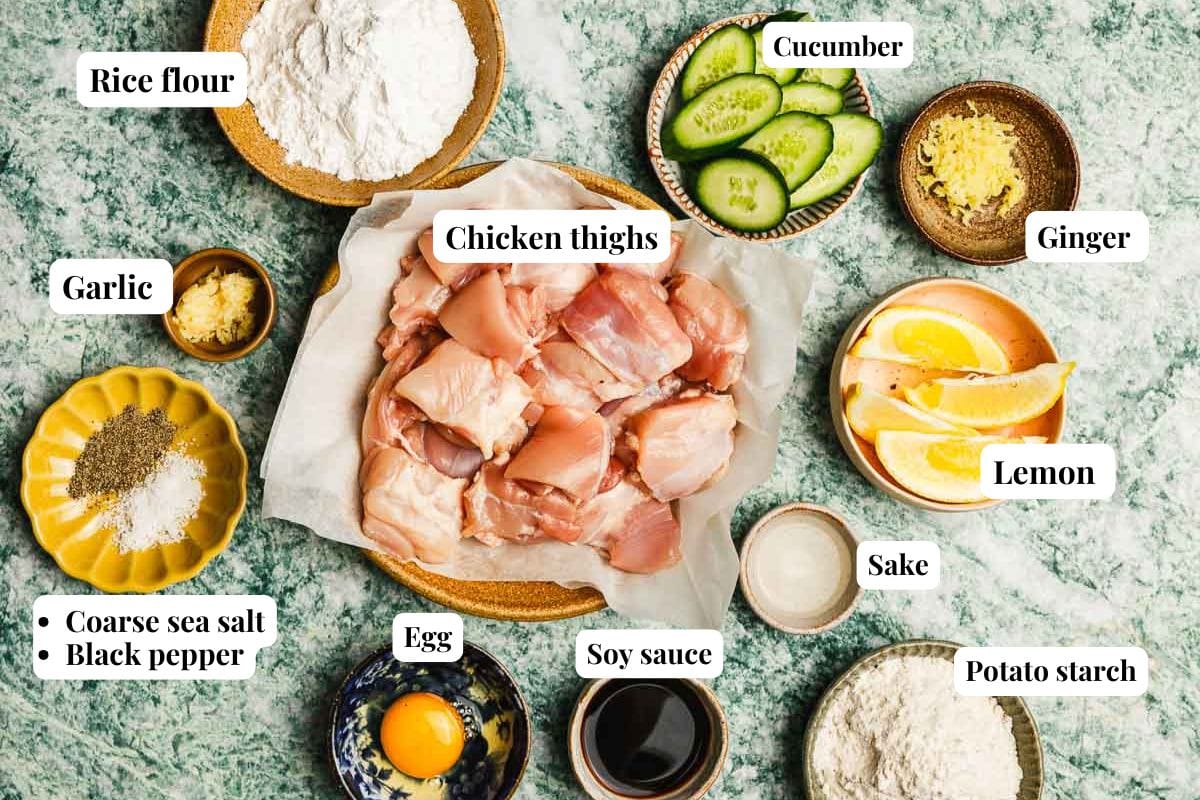
Chicken thighs (boneless and skinless)
Boneless, skinless chicken thighs are the best cut for air fryer karaage—they’re naturally juicy and flavorful, plus they hold up well to high heat. Breast meat tends to dry out, especially when reheated, so I don’t recommend using it for this recipe.
Chicken karaage marinade
A simple marinade adds depth of savory-sweet flavor. Soy sauce brings savory-umami depth—use gluten-free as needed—garlic and ginger add aromatics, and sake brings a touch of mild sweetness while helping tenderize the chicken. Salt and pepper round out the flavors.
Crispy coating (2:1 ratio of starch to flour)
A light and gluten-free coating of starch and flour gives karaage its signature airy crunch. I tested different blends and found that a 2:1 ratio of starch to flour creates the best golden, craggly coating.
- Potato starch (Katakuriko): Traditional for karaage, it creates an ultra-light, crispy texture. Tapioca starch is a good substitute—both are easy to find in Western grocery stores.
- White rice flour: This adds structure and crispness to the crust. All-purpose flour is denser, so you don’t get the airy bite this dish is known for. If you don’t have it, substitute it with more potato starch.
Egg: Mixing an egg into the marinade just before coating the chicken adds moisture. This helps the dry mix stick better and creates the textured, crunchy edges chicken karaage is known for.
Oil spray: I use avocado oil spray because it has a high smoke point and neutral taste. You can also use rice bran oil. Make sure to coat all the white spots—any powdery bits left exposed will stay pale, clumpy, and bland after frying.
How to make karaage in an air fryer
This Japanese crispy chicken recipe is easy to make at home for a Japanese-inspired weeknight dinner. For a flavorful, crispy, and juicy air fryer chicken karaage, marinate the chicken long enough, coat it well using the proper starch-to-flour ratio, and use the double-fry method.
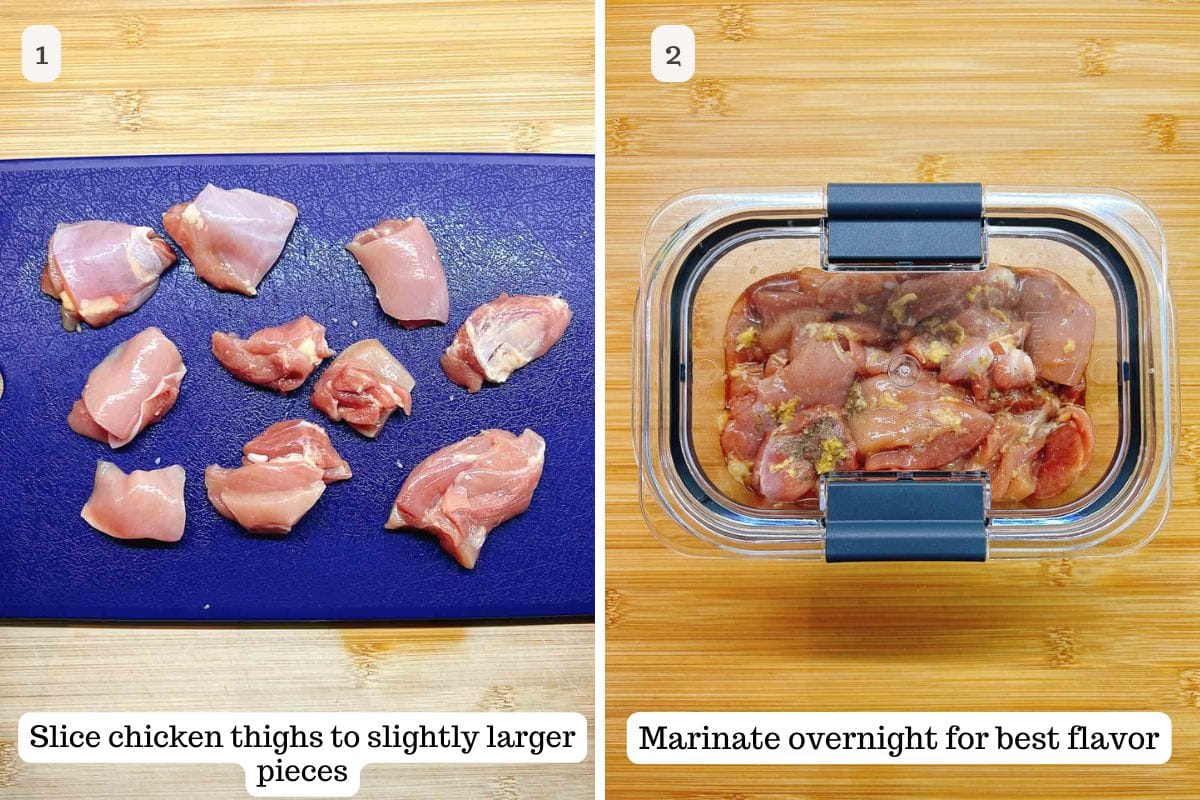
For tender, juicy chicken chunks
- I dice the thighs into slightly larger chicken pieces—around 2.25 inches (5.7 cm)—to help the inside stay tender and juicy while the coating crisps up.
Marinate for maximum flavor
- Massage the chicken chunks with the marinade for even coverage. Marinate the chicken for at least 1 hour or up to 24 hours in the fridge for a more intense flavor.
Should You Drain the Marinade? Nope—This Is Why
- Excess marinade on the chicken deepens the flavor and keeps the starch and flour coating from slipping off. If you drain the marinade, the starch coating won’t stick well, and you’ll end up with unevenly browned chicken. We’ll also add an egg to the marinated chicken before air-frying to help the coating stick.
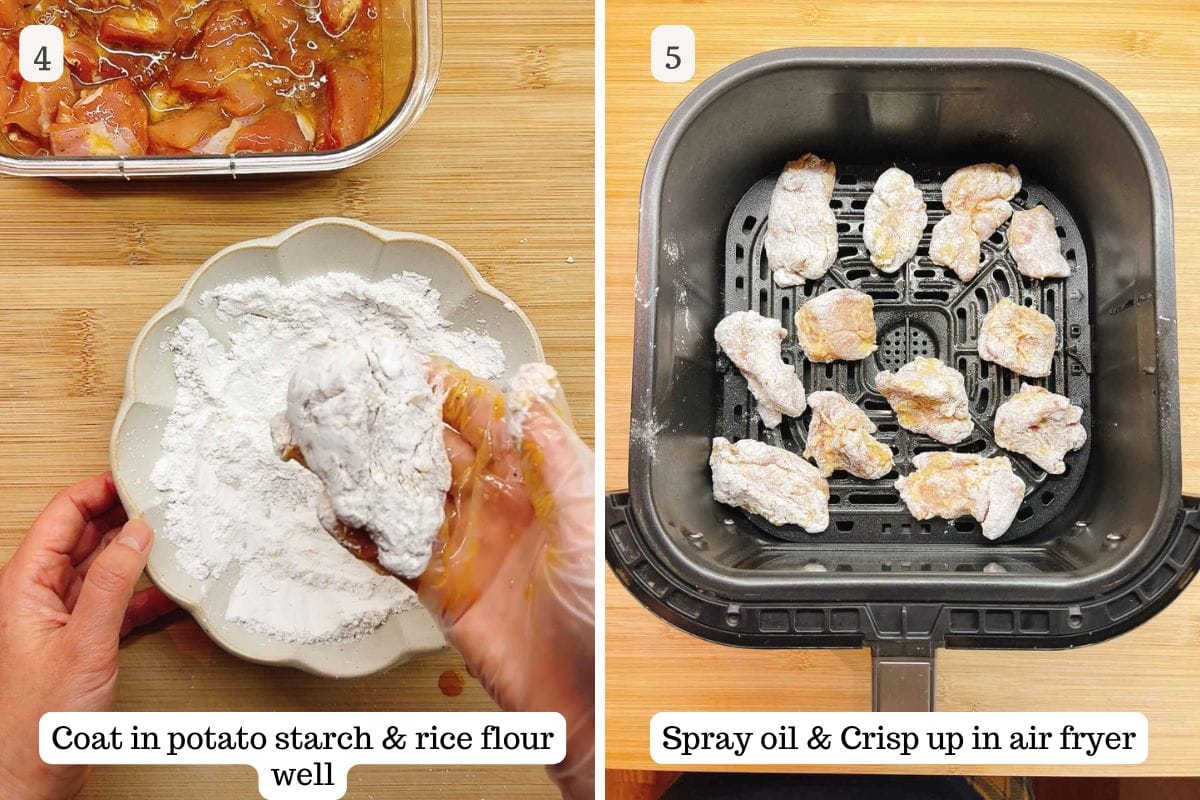
How to Get the Coating to Stick (and Stay On)
- Mix potato starch and white rice flour in a 2:1 ratio. This combo gives a light, crisp coating that won’t fall off in the air fryer. Coat each piece of chicken thoroughly and gently press the starch mixture into all sides, including crevices. There should be no pink showing—that’s your sign it’s fully coated and ready to go.
Crisp up in air fryer (double fry)
- Spray the air fryer basket with oil and place the chicken in a single layer with space between. Don’t crowd or overlap—it will lead to uneven browning. Spray the tops until no white starch is visible, or the crust may stay pale and powdery after air frying.
- Air fry at 400°F (205°C) for 8 minutes. Open the basket and wait about 10–15 seconds before flipping the pieces—this gives the coating time to set so it doesn’t stick or tear. Flip the chicken, spray the tops again, and air fry chicken karaage for another 6 minutes or until the pieces are golden brown and crispy.
Use a cooling rack
- Let the chicken rest on a cooling rack. This keeps the bottoms from getting soggy and helps the crust stay crispy. You can place the rack in a turned-off oven to keep the chicken warm between batches. This dish is best enjoyed hot and crispy!
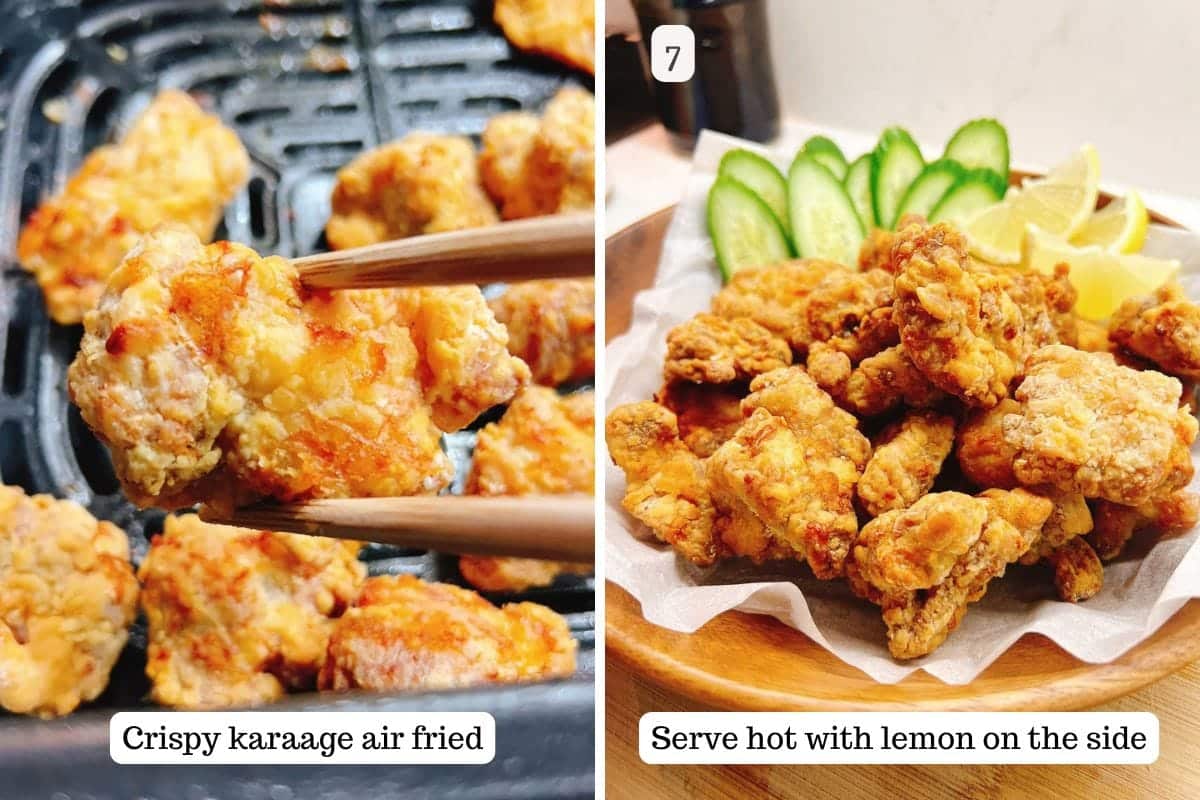
How to serve it
- Karaage is traditionally served with lemon wedges on the side and is often paired with rice and a light soup. I like to serve them with sliced lemon and Persian cucumber on the side for an extra pop of color. Don’t squeeze the lemon until just before eating—that way, the coating stays crispy!
What to serve with Japanese fried chicken
Gluten-free karaage is the ultimate healthy comfort food! Light and simple pairings will complement the rich flavors and crisp, airy texture of this chicken. The Japanese often eat it with rice and a light soup.
- Fresh Salads and Sides: This Japanese cucumber salad or a chilled silken tofu salad is perfect with this dish. Pickled daikon would add great crunch and tanginess.
- With Rice: Serve with a simple steamed rice for a traditional vibe, or opt for this golden fried rice for an extra bit of color.
- Light Soups: Serve with my aromatic daikon soup or this bok choy soup —both are light, savory, and so quick to make.
ChihYu’s helpful notes
- Use chicken thighs. They stay juicy and tender in the air fryer—breast meat tends to dry out.
- Don’t drain the marinade. The chicken should be a little wet when you coat it. This helps the coating to stick and gives you those craggly, crispy edges.
- Coat every piece really well. Make sure to get into the little crevices so the crust sticks and doesn’t tear off during cooking. Use a mix of coating and gentle pressing motion.
- Spray enough oil. If you still see dry white spots, spray more. That’s the trick to getting a golden, crispy finish.
- Wait before flipping. After the first air fry, pause 10–15 seconds before flipping to avoid tearing the coating off.
- Make-ahead and reheat: Marinate the chicken up to 24 hours in advance in an airtight container—perfect for meal prep. Got leftovers? Pop them back in the air fryer at 340°F (170°C) for 6 minutes to get that crisp back.
FAQs
Yes. In fact, these chicken bites are great for meal prep. Seal the marinated chicken in a large freezer-friendly ziplock bag. Keep it flat over a sheet pan for a flash freeze. Once solid, it can be stored in the freezer for 3 months. Defrost in the fridge overnight before coating and air frying.
Japanese fried chicken is great on its own, but you can serve it with Japanese kewpie mayo, Honey sriracha sauce, Miso ginger dressing, or a simple mix of soy sauce and lemon juice as a dipping sauce on the side.
Try these high-protein chicken bites next
If you love this crispy chicken karaage recipe, don’t miss out on my other high-protein air fryer crispy chicken bites. They’re kid-friendly meals that are family-approved!
- Taiwanese popcorn chicken with a super crunchy salt-and-pepper coating
- Air fryer lemon chicken bites made without breading or starch
- Baked crispy sesame chicken bites made on a sheet pan without starch
Air fryer karaage recipe

Video
Ingredients
- 1 lb chicken thighs boneless (skin on or off)
- ½ tsp coarse sea salt
- ¼ tsp ground black pepper
- 0.25 oz garlic clove grated, 2 medium
- 0.2 oz ginger root grated, 1.5-inch piece
- 1 tbsp soy sauce
- 1 tbsp sake
- 1 large egg
- 10 tbsp potato starch or tapioca starch, add more if needed
- 5 tbsp white rice flour or more if needed
- Avocado oil spray
Serving:
- 1 persian cucumber sliced on diagonal
- Lemon wedges
Instructions
- Chicken prep: Trim away excess fat and dice the chicken to around 2.25 inch (5.7 cm) chunks.
- Season & Marinate: Transfer the chicken to a large container and season with salt, pepper, garlic, ginger, soy sauce and sake. Gently massage to distribute the seasoning evenly. Seal the container and refrigerate for at least 1 hour (or up to a day in advance).
- Mix with egg: When you are ready to fry the chicken, add an egg into the marinade and use your hands to mix it well. There’s no need to drain the chicken. The slightly wet chicken (when in contact with the flour and starch) will create lumpy crevices and give the chicken extra crunchy coating and texture.
- Coat with starch and flour: Prepare a large mixing bowl mixed with starch and flour. Take a piece of chicken from the marinade and add it directly into the bowl. Coat and gently press the chicken well on all sides (including crevices) until you don’t see any pink spots visible. Set it aside over a large tray to catch all the chicken pieces until you finish the batch. Add more starch and flour in a 2 to 1 ratio if needed.
- Air fry (double fry): Spray the air fryer basket with a layer of oil. Place the chicken into the basket in a single layer with space between each. Spray with more oil until you don’t see any white spots. Air fry at 400°F (205 °C) for 8 minutes, open the basket (wait for 10-15 seconds before you attempt to flip), flip the chicken, spray with more oil on top, Air fry for 6 more minutes or until the chicken is golden brown.
- Cooling rack: Rest the chicken over a cooling rack to keep the bottom crisp. You can also keep the rack in an unheated oven to keep them warm. Repeat the process until you finish the entire batch.
- Serve: Transfer the chicken to a large serving plate. Arrange cucumber slices and lemon wedges on the side of the plate, but inside the rim. Don’t drizzle the lemon juice until ready to eat to keep the chicken crispy.
Notes
- Rice flour is often used to achieve a light and crispy texture. If you don’t have it, substitute it with more potato starch.
- In my recipe experiment, I found that a 2:1 ratio of starch to flour gives the most light, airy, and crispy texture.
- Don’t drain away the marinade. You want the chicken to be wet (soaked in marinade) when you dump it into the starch flour mixture. The slightly wetter chicken will grab the flour mixture well and create a more crumbly outer texture.
- Coat the chicken well with starch and flour mixture on all sides (include small crevices). If not, the wet spots will stick to the air fryer basket.
- Spray the chicken with oil until you don’t see white spots on the chicken or it will taste powder-ish and leave white spots on the chicken (as opposed to golden brown color).
- Make-ahead: Trim and dice the chicken. Marinate in an airtight container up to 24 hours in advance.
- Reheat the chicken: 340°F (171 °C) for 6 minutes.
- I do not recommend using chicken breasts for this recipe. The chicken turns dry, especially after reheating.
Nutrition
Nutrition information is automatically calculated, so should only be used as an approximation.
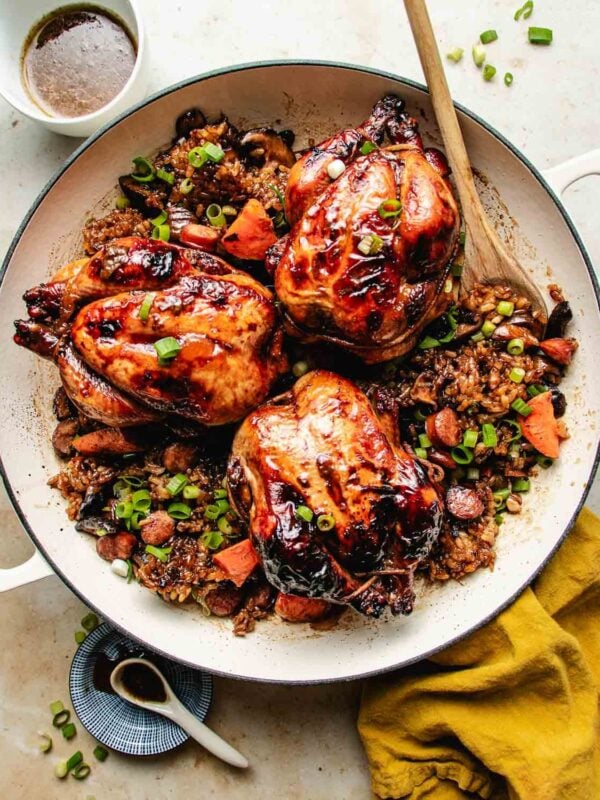
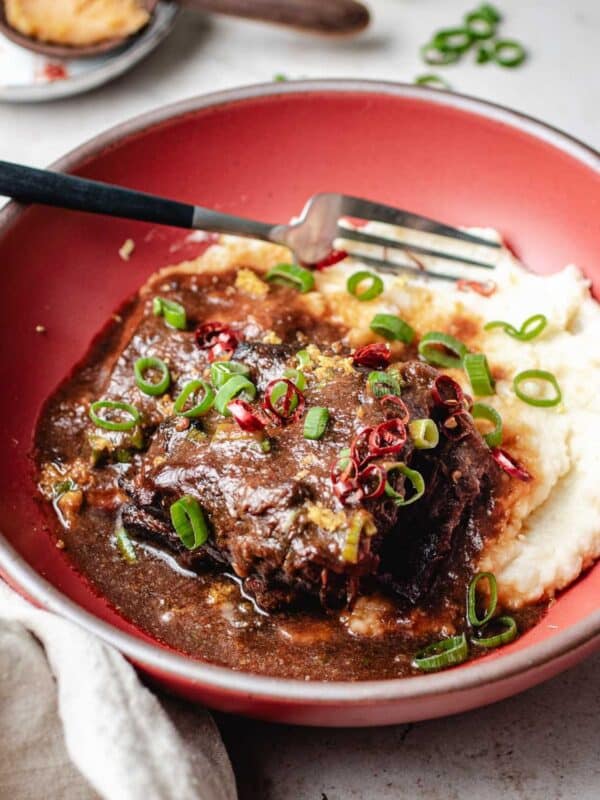
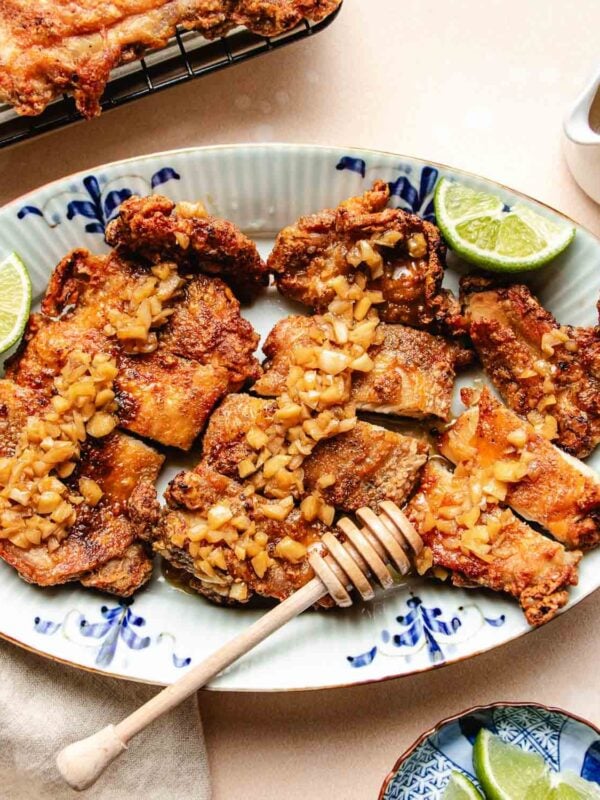

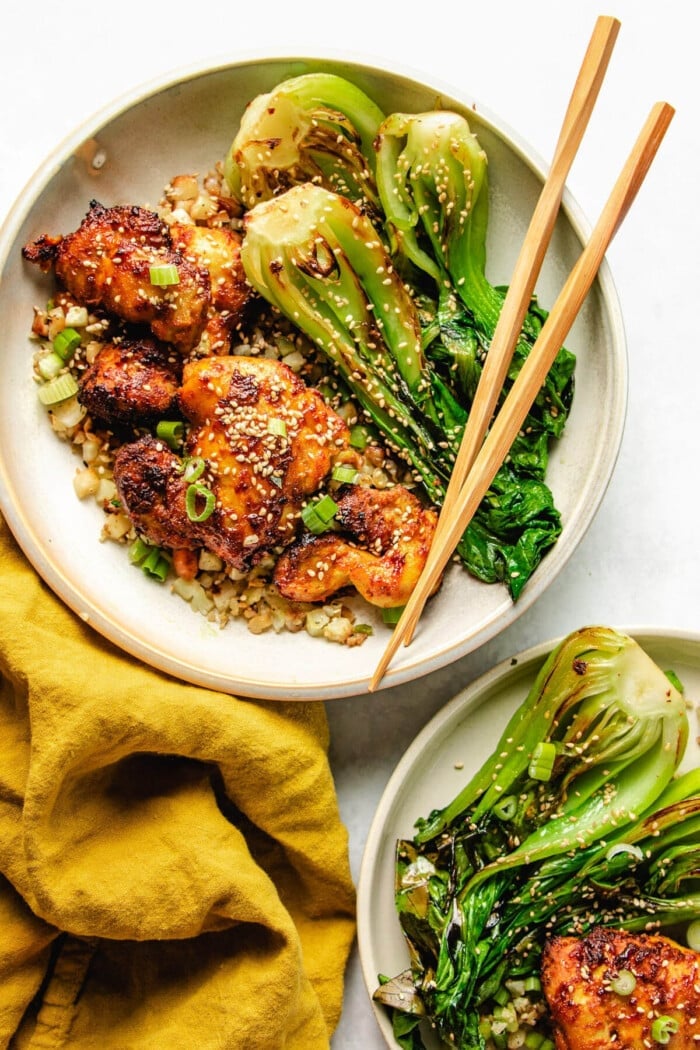








I love your recipes. I have to confess that I am a pescarian. So I’m always altering recipes to suit vegetarian and fish! It works! Thank you! Your recipes are delicious!
Thank you, Mary! I love lean proteins such as fish and seafood, too! Have you checked out my pescatarian archive? https://iheartumami.com/category/dietary/pescatarian/